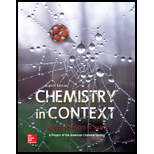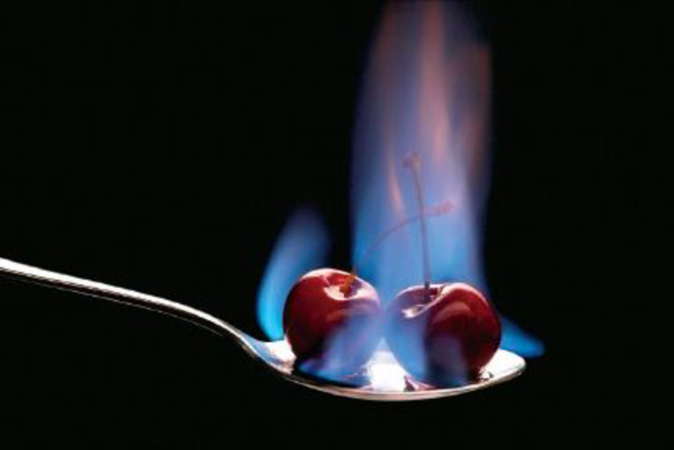
Chemistry in Context
8th Edition
ISBN: 9780073522975
Author: American Chemical Society
Publisher: McGraw-Hill Education
expand_more
expand_more
format_list_bulleted
Concept explainers
Textbook Question
Chapter 4.11, Problem 4.24YT
Have you ever been served cherries Jubilee or bananas flambé? A chef first douses the fruit in a liquor and then lights It with a match. The ethanol in the liquor burns with a dramatic blue-tinged flame.

© Bon Appetit/Alamy Stock photo
- a. Write the chemical equation for the complete combustion of ethanol—that is, burning it with enough oxygen so that only carbon dioxide and water are produced.
- b. Although it wouldn’t be very tasty, you also could pour cooking oil or biodiesel on fruit and set it afire. Write the balanced chemical equation for the complete combustion of methyl stearate, C19H38O2, the biodiesel product in Equation 5.17.
Expert Solution & Answer
Want to see the full answer?
Check out a sample textbook solution
Students have asked these similar questions
What would be the best choices for the missing reagents 1 and 3 in this synthesis?
1. PPh3
2
2. n-BuLi
3
Draw the missing reagents in the drawing area below. You can draw them in any arrangement you like.
• Do not draw the missing reagent 2. If you draw 1 correctly, we'll know what it is.
• Note: if one of your reagents needs to contain a halogen, use bromine.
Explanation
Check
Click and drag to start drawing a structure.
Predict the products of this organic reaction:
NaBH3CN
+
NH2
?
H+
Click and drag to start drawing a
structure.
×
Predict the organic products that form in the reaction below:
+ OH
+H
H+
➤ ☑ X -
Y
Note: You may assume you have an excess of either reactant if the reaction requires more than one of those molecules to form the products.
In the drawing area below, draw the skeletal ("line") structures of the missing organic products X and Y. You may draw the structures in any arrangement that
you like, so long as they aren't touching.
Click and drag to start drawing a
structure.
G
Chapter 4 Solutions
Chemistry in Context
Ch. 4.1 - Although power plants require several steps to...Ch. 4.1 - Prob. 4.3YTCh. 4.2 - Prob. 4.5CTCh. 4.3 - Prob. 4.7CTCh. 4.3 - Prob. 4.9YTCh. 4.4 - Prob. 4.10CTCh. 4.4 - The combustion of one gram of natural gas releases...Ch. 4.4 - Prob. 4.12CTCh. 4.5 - Prob. 4.14SCCh. 4.5 - Scientific Practices Coal Versus Ethanol On the...
Ch. 4.6 - Prob. 4.17YTCh. 4.7 - Beginning in the 1920s, the octane-booster...Ch. 4.9 - Prob. 4.21CTCh. 4.10 - Prob. 4.22CTCh. 4.11 - Have you ever been served cherries Jubilee or...Ch. 4.11 - Prob. 4.26CTCh. 4 - Prob. 4.1CTCh. 4 - Prob. 1QCh. 4 - Prob. 2QCh. 4 - Prob. 3QCh. 4 - Energy exists in different forms in our natural...Ch. 4 - A coal-burning power plant generates electrical...Ch. 4 - Prob. 6QCh. 4 - Prob. 7QCh. 4 - Prob. 8QCh. 4 - Mercury (Hg) is present in trace amounts in coal,...Ch. 4 - Prob. 10QCh. 4 - Here are the condensed structural formulas for two...Ch. 4 - Prob. 12QCh. 4 - Prob. 13QCh. 4 - Prob. 14QCh. 4 - During petroleum distillation, kerosene and...Ch. 4 - Prob. 16QCh. 4 - a. Write the balanced chemical equation for the...Ch. 4 - Prob. 18QCh. 4 - Prob. 19QCh. 4 - State whether these processes are endothermic or...Ch. 4 - Use the bond energies in Table 5.1 to calculate...Ch. 4 - Use the bond energies in Table 5.1 to calculate...Ch. 4 - Ethanol can be produced by fermentation. Another...Ch. 4 - Here are structural formulas for ethane, ethene...Ch. 4 - These three compounds all have the same chemical...Ch. 4 - Catalysts speed up cracking reactions in oil...Ch. 4 - Explain why cracking is a necessary part of the...Ch. 4 - Consider this equation representing the process of...Ch. 4 - Prob. 29QCh. 4 - Consider these three alcohols: methanol, ethanol,...Ch. 4 - Prob. 31QCh. 4 - Prob. 32QCh. 4 - Prob. 33QCh. 4 - Compare and contrast a molecule of biodiesel with...Ch. 4 - Use Figure 5.6 to compare the energy released for...Ch. 4 - Prob. 36QCh. 4 - The sustainability of burning coal (and other...Ch. 4 - In this chapter, we approximated the chemical...Ch. 4 - Prob. 39QCh. 4 - Compare the processes of combustion and...Ch. 4 - How might you explain the difference between...Ch. 4 - Write a response to this statement: Because of the...Ch. 4 - The concept of entropy and probability is used in...Ch. 4 - Bond energies such as those in Table 5.1 are...Ch. 4 - Use the bond energies in Table 5.1 to explain why...Ch. 4 - Prob. 46QCh. 4 - Prob. 47QCh. 4 - Prob. 48QCh. 4 - Prob. 49QCh. 4 - Prob. 50QCh. 4 - Prob. 51QCh. 4 - Prob. 52QCh. 4 - Prob. 53QCh. 4 - Use a diagram to show the relationship among these...Ch. 4 - On a timescale of a few years, the combustion of...Ch. 4 - Prob. 56QCh. 4 - Emissions of some pollutants are lower when...Ch. 4 - Although coal contains only trace amounts of...Ch. 4 - Prob. 59QCh. 4 - An article in Scientific American pointed out that...Ch. 4 - C. P. Snow, a noted scientist and author, wrote an...Ch. 4 - Chemical explosions are very exothermic reactions....Ch. 4 - Prob. 64QCh. 4 - Tetraethyllead (TEL) was first approved for use in...Ch. 4 - Tetraethyllead (TEL) has an octane rating of 270....Ch. 4 - Another type of catalyst used in the combustion of...Ch. 4 - Figure 5.8 shows energy differences for the...Ch. 4 - Prob. 69Q
Knowledge Booster
Learn more about
Need a deep-dive on the concept behind this application? Look no further. Learn more about this topic, chemistry and related others by exploring similar questions and additional content below.Similar questions
- Predict the organic products that form in the reaction below: OH H+ H+ + ☑ Y Note: You may assume you have an excess of either reactant if the reaction requires more than one of those molecules to form the products. In the drawing area below, draw the skeletal ("line") structures of the missing organic products X and Y. You may draw the structures in any arrangement that you like, so long as they aren't touching. Click and drag to start drawing a structure. ✓ marrow_forwardDetermine the structures of the missing organic molecules in the following reaction: + H₂O +H H+ Y Z ☑ ☑ Note: Molecules that share the same letter have the exact same structure. In the drawing area below, draw the skeletal ("line") structures of the missing organic molecules X, Y, and Z. You may draw the structures in any arrangement that you like, so long as they aren't touching. Molecule X shows up in multiple steps, but you only have to draw its structure once. Click and drag to start drawing a structure. AP +arrow_forwardPlease help, this is all the calculations i got!!! I will rate!!!Approx mass of KMnO in vial: 3.464 4 Moss of beaker 3×~0. z Nax200: = 29.9219 Massof weacerv after remosimgain N2C2O4. Need to fill in all the missing blanks. ง ง Approx mass of KMnO4 in vials 3.464 Mass of beaker + 3x ~0-304: 29.9219 2~0.20 Miss of beaker + 2x- 29.7239 Mass of beaker + 1x~0.2g Naz (204 29-5249 Mass of beaver after removing as qa Na₂ C₂O T1 T2 T3 Final Buiet reading Initial butet reading (int)) Hass of NaOr used for Titration -reading (mL) calculation Results: 8.5ml 17mL 27.4mL Oml Om Oml T1 T2 T3 Moles of No CO Moles of KMO used LOF KM. O used Molenty of KMNO Averagem Of KMOWLarrow_forward
- Draw the skeletal ("line") structure of 2-hydroxy-4-methylpentanal. Click and drag to start drawing a structure. Xarrow_forwardDetermine whether the following molecule is a hemiacetal, acetal, or neither and select the appropriate box below. Also, highlight the hemiacetal or acetal carbon if there is one. hemiacetal acetal Oneither OHarrow_forwardWhat is the missing reactant R in this organic reaction? ་ ་ ་ ་ ་ ་ ་ ་ ་ ་ +R H3O+ • Draw the structure of R in the drawing area below. N • Be sure to use wedge and dash bonds if it's necessary to draw one particular enantiomer. Click and drag to start drawing a structure.arrow_forward
- Write the systematic name of each organic molecule: H structure H OH OH H OH name ☐ OHarrow_forwardDetermine whether each of the following molecules is a hemiacetal, acetal, or neither and select the appropriate box in the table. CH3O OH OH OH hemiacetal acetal neither hemiacetal acetal neither Xarrow_forwardWhat is the missing reactant R in this organic reaction? N N དལ་ད་་ + R • Draw the structure of R in the drawing area below. • Be sure to use wedge and dash bonds if it's necessary to draw one particular enantiomer. Click and drag to start drawing a structure. ㄖˋarrow_forward
- Draw the condensed structure of 4-hydroxy-3-methylbutanal. Click anywhere to draw the first atom of your structure.arrow_forwardUsing the bond energy values, calculate the energy that must be supplied or is released upon the polymerization of 755 monomers. If energy must be supplied, provide a positive number; if energy is released, provide a negative number. Hint: Avogadro’s number is 6.02 × 1023.arrow_forward-AG|F=2E|V 3. Before proceeding with this problem you may want to glance at p. 466 of your textbook where various oxo-phosphorus derivatives and their oxidation states are summarized. Shown below are Latimer diagrams for phosphorus at pH values at 0 and 14: Acidic solution -0.93 +0.38 -0.51 -0.06 H3PO4 →H4P206 H3PO3 H3PO2 → P→ PH3 -0.28 -0.50 → -0.50 Basic solution 3-1.12 -1.57 -2.05 -0.89 PO HPO →→H2PO2 P PH3 -1.73 a) Under acidic conditions, H3PO4 can be reduced into H3PO3 directly (-0.28V), or via the formation and reduction of H4P2O6 (-0.93/+0.38V). Calculate the values of AG's for both processes; comment. (3 points) 0.5 PH, 0.0 -0.5- 2 3 9 3 -1.5 -2.0 Pa H,PO H,PO H,PO -3 -1 0 2 4 Oxidation state, N 2 b) Frost diagram for phosphorus under acidic conditions is shown. Identify possible disproportionation and comproportionation processes; write out chemical equations describing them. (2 points) c) Elemental phosphorus tends to disproportionate under basic conditions. Use data in…arrow_forward
arrow_back_ios
SEE MORE QUESTIONS
arrow_forward_ios
Recommended textbooks for you
 Chemistry for Engineering StudentsChemistryISBN:9781337398909Author:Lawrence S. Brown, Tom HolmePublisher:Cengage Learning
Chemistry for Engineering StudentsChemistryISBN:9781337398909Author:Lawrence S. Brown, Tom HolmePublisher:Cengage Learning World of ChemistryChemistryISBN:9780618562763Author:Steven S. ZumdahlPublisher:Houghton Mifflin College Div
World of ChemistryChemistryISBN:9780618562763Author:Steven S. ZumdahlPublisher:Houghton Mifflin College Div Chemistry: The Molecular ScienceChemistryISBN:9781285199047Author:John W. Moore, Conrad L. StanitskiPublisher:Cengage Learning
Chemistry: The Molecular ScienceChemistryISBN:9781285199047Author:John W. Moore, Conrad L. StanitskiPublisher:Cengage Learning
 World of Chemistry, 3rd editionChemistryISBN:9781133109655Author:Steven S. Zumdahl, Susan L. Zumdahl, Donald J. DeCostePublisher:Brooks / Cole / Cengage Learning
World of Chemistry, 3rd editionChemistryISBN:9781133109655Author:Steven S. Zumdahl, Susan L. Zumdahl, Donald J. DeCostePublisher:Brooks / Cole / Cengage Learning Introductory Chemistry: A FoundationChemistryISBN:9781337399425Author:Steven S. Zumdahl, Donald J. DeCostePublisher:Cengage Learning
Introductory Chemistry: A FoundationChemistryISBN:9781337399425Author:Steven S. Zumdahl, Donald J. DeCostePublisher:Cengage Learning

Chemistry for Engineering Students
Chemistry
ISBN:9781337398909
Author:Lawrence S. Brown, Tom Holme
Publisher:Cengage Learning

World of Chemistry
Chemistry
ISBN:9780618562763
Author:Steven S. Zumdahl
Publisher:Houghton Mifflin College Div

Chemistry: The Molecular Science
Chemistry
ISBN:9781285199047
Author:John W. Moore, Conrad L. Stanitski
Publisher:Cengage Learning


World of Chemistry, 3rd edition
Chemistry
ISBN:9781133109655
Author:Steven S. Zumdahl, Susan L. Zumdahl, Donald J. DeCoste
Publisher:Brooks / Cole / Cengage Learning

Introductory Chemistry: A Foundation
Chemistry
ISBN:9781337399425
Author:Steven S. Zumdahl, Donald J. DeCoste
Publisher:Cengage Learning
Calorimetry Concept, Examples and Thermochemistry | How to Pass Chemistry; Author: Melissa Maribel;https://www.youtube.com/watch?v=nSh29lUGj00;License: Standard YouTube License, CC-BY